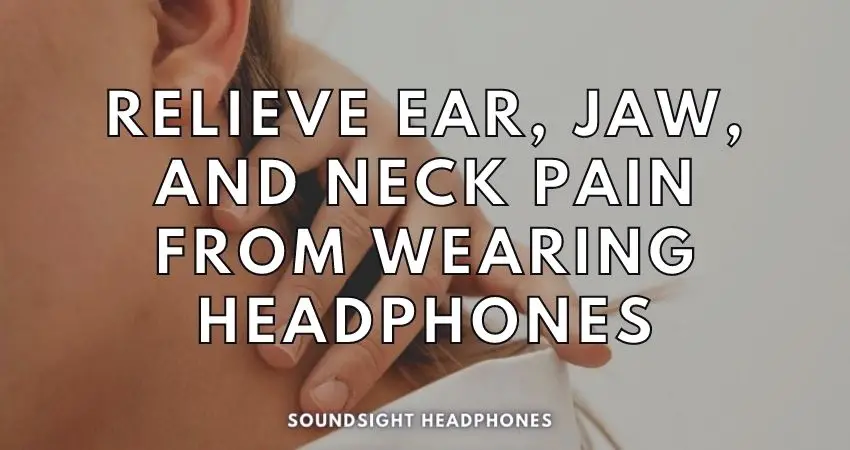Experiencing headphone-related pain can be an irksome ordeal—often manifesting as ear and jaw pain, headaches, or discomfort on the head’s crown. One common issue that arises from headphone usage is headphones and neck pain.
If you’ve ever wondered, “Can headphones cause neck pain?” or “Why do headphones hurt the top of my head?”, this guide addresses these concerns and offers practical tips and solutions for the different reasons behind ear and jaw pain, as well as neck strain related to headphone usage.
We’ll also provide you with a curated list of highly comfortable, top-quality headphones.
So, let’s get started and put an end to your headphone-related agony!
Can Headphones Cause Neck Pain?
When headphones cause neck pain, it is often due to heavy headphones leading to neck strain and poor posture.

Forward head posture can add up to 30 pounds of abnormal leverage on the cervical spine, pulling the entire spine out of alignment. Crazy, right?
In fact, a 2014 study found that the forward position of the head puts increasing amounts of weight pressure on the spine, with the head weighing approximately 10–14 pounds.
The table below illustrates the relationship between the angle of head tilt and the corresponding spinal pressure:
| Head Tilt Angle | Spinal Pressure |
|---|---|
| 15 degrees | 27 pounds |
| 30 degrees | 40 pounds |
| 45 degrees | 49 pounds |
| 60 degrees | 60 pounds |
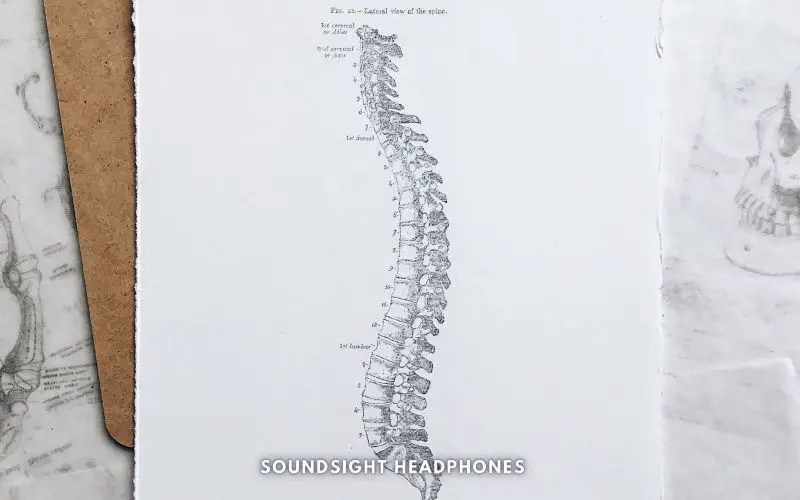
Even if your posture is perfect, and you’re holding your head upright, there’s still going to be at least 5 to 11 pounds of pressure on your spine (and that’s without headphones). So headphones causing neck strain isn’t out of the ordinary even when you’re everything right.
Furthermore, although there are no studies on headphones, research shows that head-mounted displays affect posture. Simultaneously, wearing headphones can lead to improper posture, which in turn can exacerbate neck pain and put extra pounds of pressure on the spine.
So, not only do you risk hearing damage from headphones, but you’re also wreaking havoc on your spine.
How to Relieve Neck Pain From Headphones
Maintaining correct posture and wearing your headphones correctly can effectively alleviate the neck pain caused by headphones.
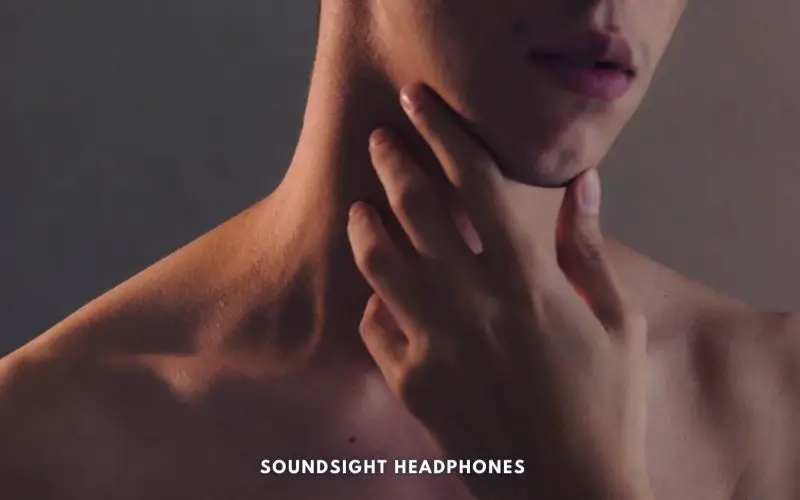
Chin tucks—drawing your chin in towards your chest—can help to alleviate discomfort in the immediate term. In the long run, however, it’s important to actively strengthen the neck muscles to ensure continued comfort and prevent neck pain from headphone use.
Chin Tucks
Chin tucks are a game-changer for anyone who suffers from headphone-induced neck pain. They’re easy to do and can be done anywhere, anytime.
Here’s how to perform a chin tuck:
- Sit or stand up straight, with your shoulders relaxed
- Gently tuck your chin in towards your chest, creating a double chin
- Hold for 5 seconds, then release
- Repeat 10 times, 2-3 times a day
Pro tip: You can also do chin tucks while lying down, known as supine chin tucks. Just lie on your back, tuck your chin in, and hold for 5 seconds.
Strengthening the Neck Muscles
While chin tucks provide immediate relief, it’s essential to address the root cause of the problem—weak neck muscles. Incorporate these neck exercises into your daily routine:
- Neck stretches: Gently tilt your head to one side, then the other, holding each stretch for 15-30 seconds
- Shoulder rolls: Roll your shoulders forward and backward in a circular motion, 10 times each direction
- Neck rotations: Slowly turn your head from side to side, holding each position for 5 seconds
Proper Headphone Use
Lastly, don’t forget to wear your headphones correctly. An imbalanced center of gravity can cause headaches from misplaced headphones.
Proper Posture
Even if your head is not tilted, if you slouch or have poor posture while wearing headphones, it can still contribute to neck pain.
Tips for Maintaining Good Posture
- Align ears, shoulders, and hips vertically; sit straight
- Keep feet flat, uncrossed legs and ankles
- Take breaks, move frequently
- Keep work items within reach
- Use pillows for back support and leg bending during sleep
Exercises to Improve Posture
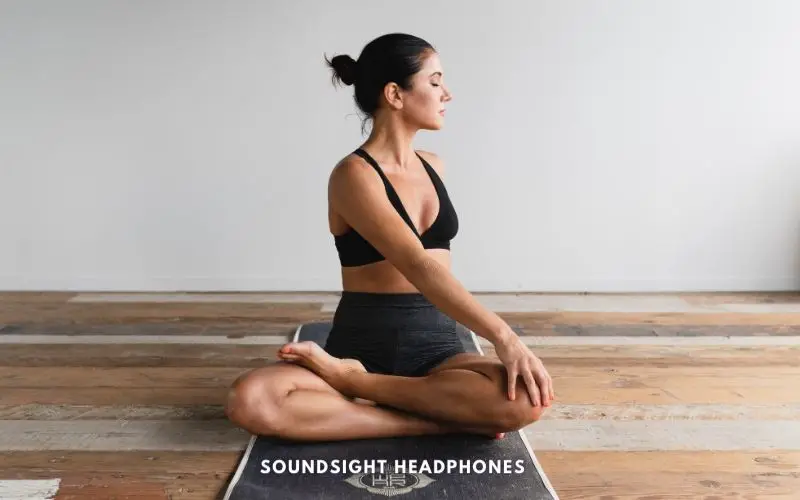
- Core stabilizers: Single leg extension, Pilates roll-up/yoga sit-up, crossover, cobra pose
- Wall angels, side lying shoulder exercise, prone lying scapular exercise, theraband rows
- Forward fold, downward-facing dog, mountain pose, child’s pose
- Decompression: doorway stretch, cat-cow.
Ear Cartilage Pain: How Headphones Can Hurt
Overly tight headphones can also make your ear cartilage scream for mercy. When headphones press too firmly against your ears, they can cause discomfort and pain.
What to do in this situation?
Loosen your headphones headband by placing them on a box. If that doesn’t work, buy a pair of ear pads replacement that provide a snug yet gentle fit around your ears. Similarly, you can look for headphones ear covers that add a bit of padding like memory foam or gel to provide added comfort.
Thinner, worn-out ear pads often cause discomfort, so replacing them with thicker, more cushioned ear pads can help alleviate the pressure on your ear cartilage.
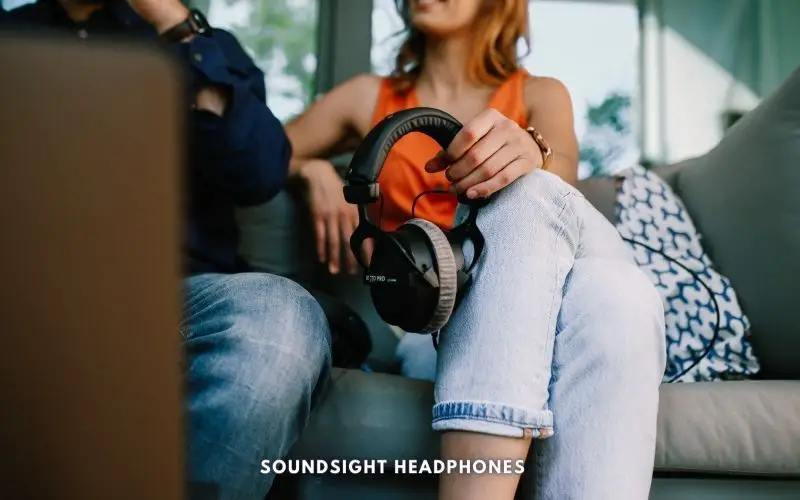
Taking breaks to prevent ear cartilage pain is another solution. If you continuously wear headphones for 8 hours, it’s only normal for your ears to feel sore and uncomfortable.
Wireless Earphones and Wearing Comfort
In a study by Song 2020, it was discovered that the shape and operation method of wireless earphones play a significant role in wearing comfort.
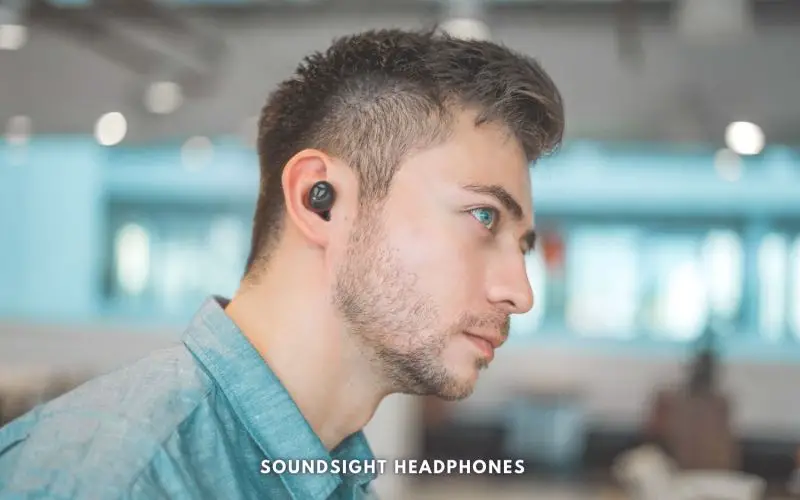
Touch-input types emerged as the lesser evil, causing less pain than their button-press counterparts.
So, if you’re looking to avoid the dreaded ear cartilage pain, it might be time to ditch those old-school button-press earphones and embrace the touch-input technology. Also, avoid using in-ear headphones for extended periods.
Addressing “Headphones Hurt My Head”
Compression headaches from headphones result from:
- Pressure (high clamping force)
- Weight (heavy headphones causing strain on the neck and head)
- Positioning (improper alignment of the headphone band or ear cups)
- Material rigidity.
First, the squeezing sensation or tightness at the temples can be improved by adjusting the size of your headphones. Many headsets come with adjustable straps and/or ear cups for a better fit. Headphones should be snug but also comfortable – not overly tight.
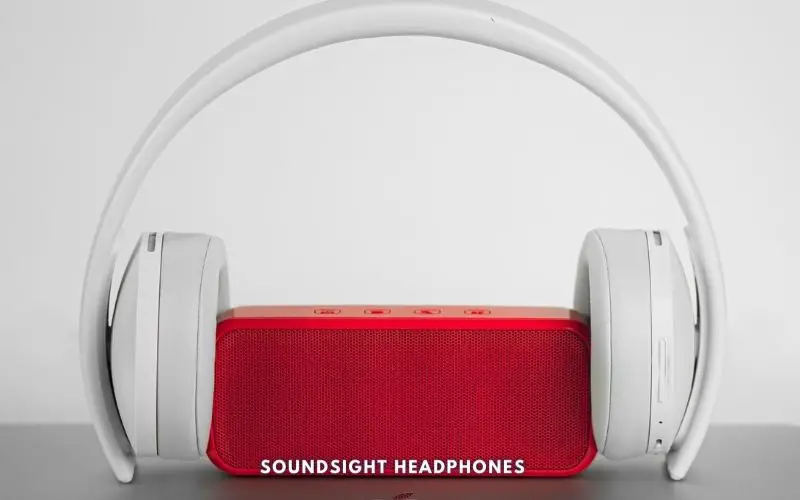
Tweak the headphone fit and placement for maximum comfort. An imbalanced center of gravity can cause headaches from misplaced headphones.
Ultimately, be mindful of bass, volume, and ANC headphones, as they may contribute to headaches and vertigo.
Headphones Hurt the Top of My Head: Causes & Fixes
Unlike compression headaches, headphones hurting the top of the head is an issue caused by low clamping force and extra downward pressure.
Low clamping force on the ears can cause the top of your head to hurt. It’s a delicate balance—too loose, and your headphones put pressure on the top of your head; too tight, and you’re left with ear pain.
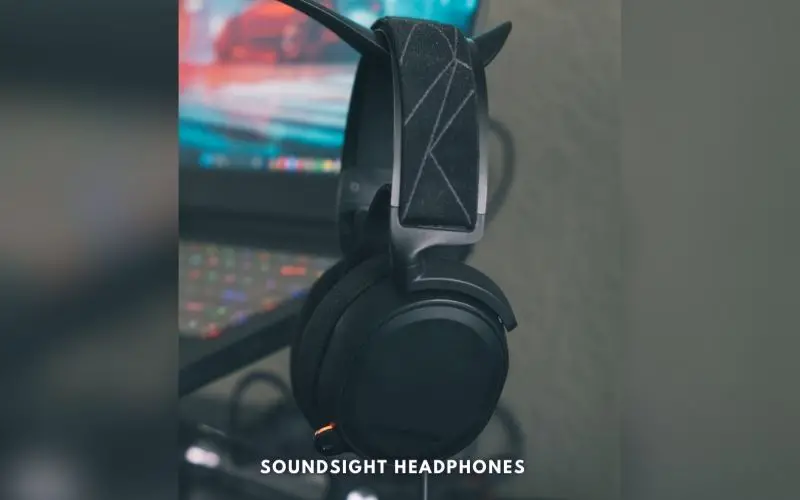
This headphone-related headache can also stem from uneven weight distribution and rigid materials, causing strain and poor fit on the head’s contours.
To alleviate this distress, consider the following solutions:
- Adjust the headband of the headphone.
- Add a headband cushion pad cover
- Look for models with sufficient padding—memory foam is particularly effective at reducing pressure points or with flexible headbands like AKG K702 or SteelSeries headsets.
- Explore lightweight headphones, as they are less likely to cause discomfort.
- Tighten the headphones using a rubber band.
Headphones Hurt my Jaw
Headphones are convenient and comfortable until…your jaw begins to ache! Now you might be thinking, “Wait, what? How can headphones cause jaw pain?” But don’t worry—the aching sensation when wearing headphones can be fixed.
When you wear headphones, your ears are closer to your jaw muscles, which can lead to temporal tension. This tension, in turn, can cause you to unconsciously clench your jaw, resulting in discomfort and pain.
Jaw Pressure from Over-ear Headphones
Experiencing jaw pain due to over-ear headphones is fairly rare. Though if you have headphones with large round ear pads that are also tight, the clamping force exerts pressure on the temporal and mandibular joints, which leads to jaw aches.
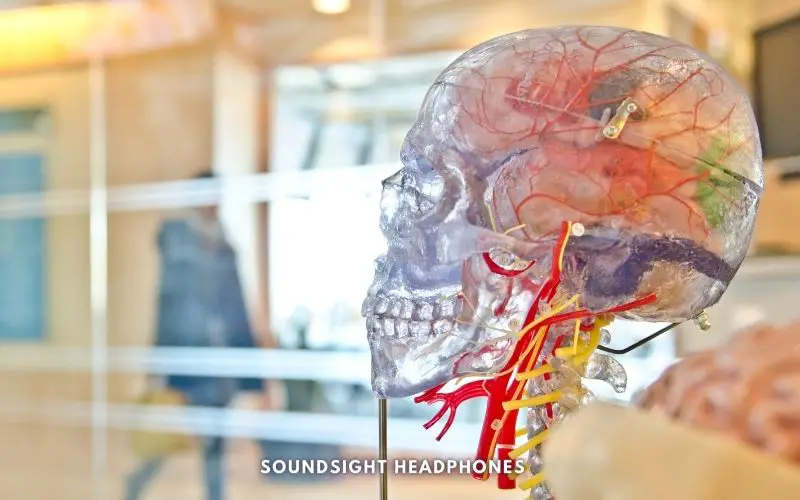
Sadly, headphones often press up against your head, with the lower part of the ear cups resting on your jaw. However, there is no strong evidence that headphones cause TMJ disorders.
In-ear Headphones and Jaw Discomfort
In-ear headphones can potentially cause jaw discomfort due to their insertion into the ear canal. An improper fit may lead to undue pressure on the jaw, resulting in pain.
To address jaw discomfort from in-ear headphones, use custom-fit ear tips with an ergonomic design, hypoallergenic materials, and a secure fit to minimize discomfort.
Ensure proper earbud/IEM insertion by following these steps:
- Place earbud tips in ears and push in slightly.
- Use the opposite hand to pull the earlobe downwards, widening the ear canal.
- Gently push the earbud further into an ear with the index finger, creating a seal.
- Release the earlobe and repeat for the other ear.
- Experiment with different tip sizes and materials for the perfect seal.
Refer to this article for visual cues on how to insert earbuds into the ear.
Lastly, consult audiologists and consider custom-made acryl earbuds tailored to your ear shape for optimal comfort, fit, sound isolation, and audio quality to address in-ear headphone and jaw discomfort issues.
Tips for Reducing Jaw Pain from Headphones
Experiencing jaw pain relief can be a challenge, especially when it’s caused by headphones. Nonetheless, various efficient methods to ease discomfort are available:
- Discover how to relieve jaw pain through informative resources, such as this video
- Gently massage the masseter muscle—the primary muscle responsible for jaw movement
- Incorporate targeted exercises to strengthen and relax the jaw muscles
- Regularly stretch the jaw muscles to reduce tension
- Loosen the headband to reduce the clamping force
Relieving most discomforts caused by headphones is a matter of incorporating some exercises like gentle neck and head stretches to alleviate tension. Remember what Elle Woods said in Legally Blonde, “Exercise gives you endorphins. Endorphins make you happy!”
Comfortable Headphones
If you’re looking for comfortable headphones to combat future headaches and neck pain, consider the following:
- Sennheiser HD 599: Open-back design, balanced sound, luxurious ear pads, audiophile-grade quality.
- Bose QuietComfort 35: Noise-cancelling, wireless, comfortable fit, long battery life, excellent sound quality.
- Bose Noise Cancelling Headphones 700: Sleek design, adaptive noise-cancellation, touch controls, voice assistant integration, premium sound.
- Sony WH1000-XM4: Industry-leading noise-cancellation, customizable sound, touch controls, smart listening features, comfortable fit.
- Jabra Evolve2 85 Wireless: Professional-grade, active noise-cancellation, 10-microphone call technology, 37-hour battery life, comfortable design.
- Meze 99 Classics: Handcrafted wooden design, balanced sound, comfortable memory foam ear pads, detachable cables, stylish aesthetics.
- Beyerdynamic DT 1990 Pro: Open-back studio headphones, precise sound, durable build, replaceable.
- Audio-Technica ATH-M50x: Professional-grade sound quality, 90-degree swiveling ear cups, comfortable padding, detachable cable, collapsible design.
With long hours spent hunched over and constant use of headphones, it’s no wonder that headphone-related pain is becoming a common complaint. Thus far, avoiding neck pain from wearing headphones requires a comfortable, lightweight, and ergonomic headset that distributes weight evenly and minimizes pressure on the head and neck.
References
- Knight, J. F., & Baber, C. (2007). Effect of Head-Mounted Displays on Posture. Human Factors, 49(5), 797–807. https://doi.org/10.1518/001872007X230172
- Joshi R, Poojary N. The Effect of Muscle Energy Technique and Posture Correction Exercises on Pain and Function in Patients with Non-specific Chronic Neck Pain Having Forward Head Posture-a Randomized Controlled Trail. Int J Ther Massage Bodywork. 2022 Jun 1;15(2):14-21. doi: 10.3822/ijtmb.v15i2.673. PMID: 35686175; PMCID: PMC9134480.
- Song, H.; Shin, G.W.; Yoon, Y.; Bahn, S. The Effects of Ear Dimensions and Product Attributes on the Wearing Comfort of Wireless Earphones. Appl. Sci. 2020, 10, 8890. https://doi.org/10.3390/app10248890
